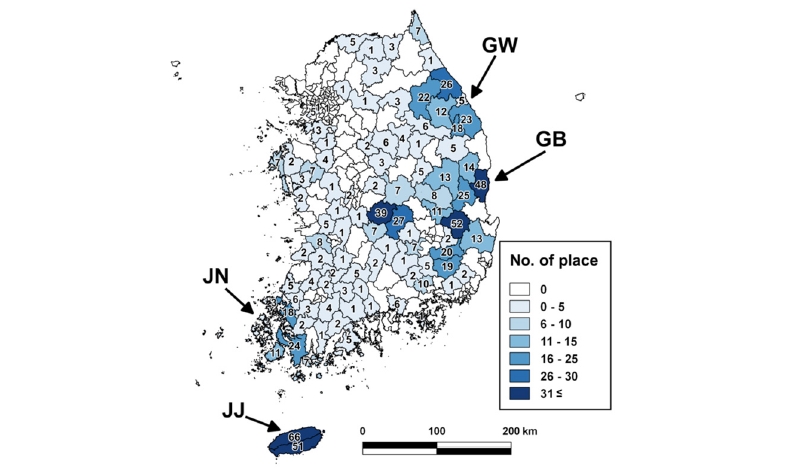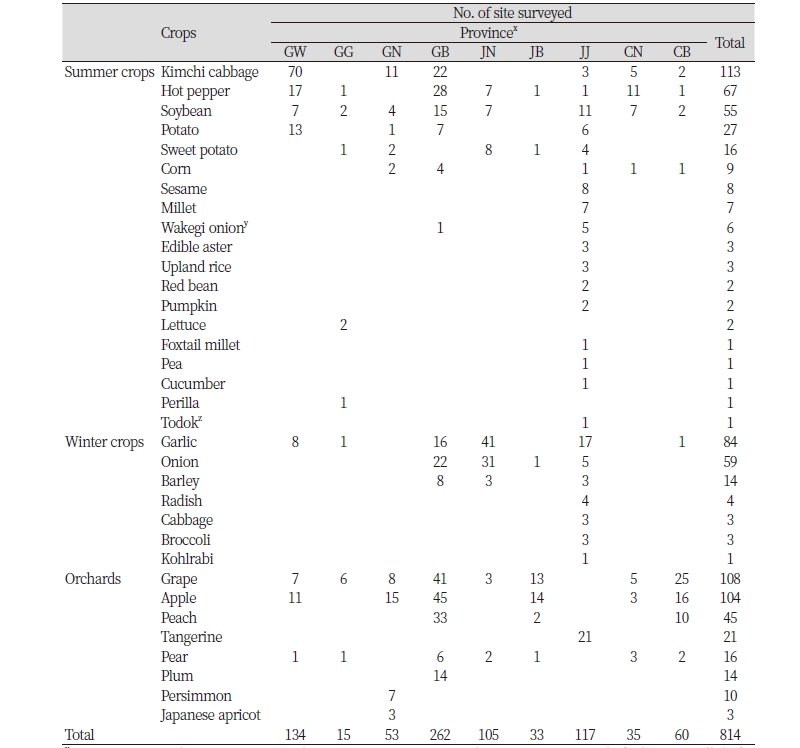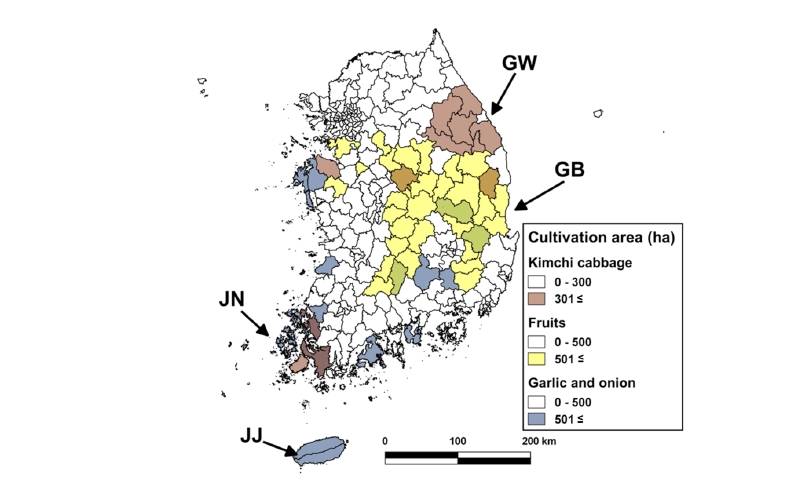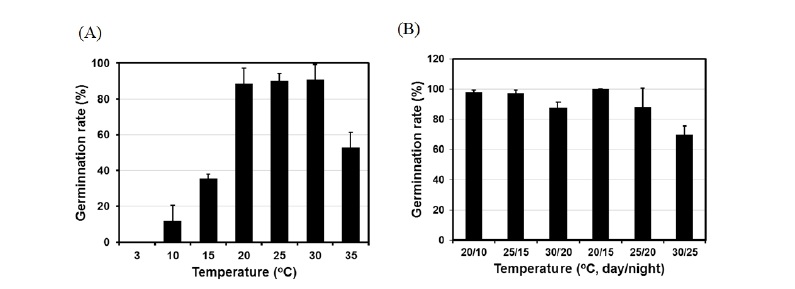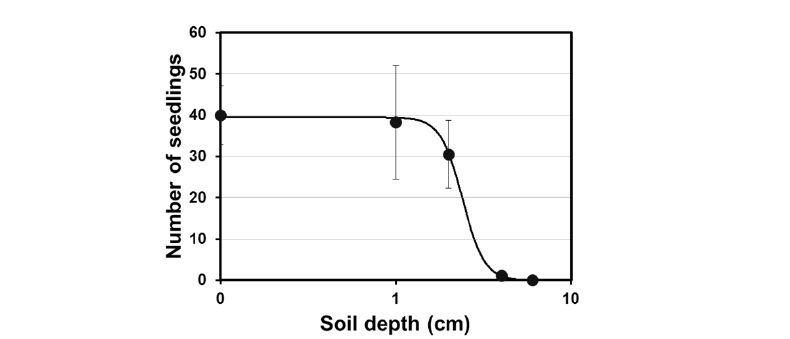Introduction
Common groundsel (Senecio vulgaris L.) is an annual or winter annual Asteraceae. Senecio vulgaris possesses 2n=4x=40 chromosomes (Chang and Chung, 2011) and its genome is approximately 1.63 ρg 1 C-1 and 3.2 Gbp (Garnatje et al., 2011). This plant was divided into two subspecies based on the presence of ray florets: S. vulgaris subsp. vulgaris is the non-radiate form (no ray florets), and S. vulgaris subsp. denticulatus (syn. subsp. hybernicus) is the radiate form (ray florets).
Senecio vulgaris originated from Europe and is distributed around the world, including the US (USDA, 2017), except for tropical and sub-tropical regions in South-East Asia and Africa (CABI, 2017). Senecio vulgaris is an exotic weed introduced in Korea before 1921 (Mori, 1922), and distributed nationwide before the 1980s (Yim and Jeon, 1980). Kang and Shim (2002) reported that S. vulgaris has dispersed as widely and evenly as daisy fleabane (Erigeron annuus) which is one of the most common exotic weeds in Korea.
Recently, farmers who have been cultivating winter crops, such as garlic and onion in southern Korea, reported a dominant presence of S. vulgaris in the field. However, there is currently no information in Korea regarding the distribution of this plant. Previous studies have examined the weed flora of croplands on national (Lee et al., 2015; Lee et al., 2017) and small regional scales (Choi et al., 2009). These studies have focused on the diversity and composition of these weeds, but their distribution and crop-weed relationship have largely been ignored.
One of the most important aspects of weed control is understanding the germination characteristics of the target weeds. Germination of S. vulgaris differs by the time of seed setting (Popay and Roberts, 1970), as well as the climate condition of the habitat (Ndihokubwayo et al., 2016). However, so far no studies discussed the germination characteristics of S. vulgaris in Korea, and control methods based on germination physiology are consequently lacking in Korea.
In Korea, there are two methods used for weed management in winter crops: vinyl mulching and pre-emergence herbicide application. Due to the advantages of vinyl mulching (e.g., increasing soil temperature for successful rooting), the former has been widely and conventionally used in Korea. The herbicides, however, are rarely used due to their low performance at low temperatures and lack of information about efficacy to winter annual weeds.
Therefore, this study aimed to understand the current situation concerning the dominance of S. vulgaris through a distribution analysis, as well as to determine an effective and efficient method of controlling this invasive plant through germination physiology and herbicidal response.
Materials and Methods
Geographical distribution of S. vulgaris in Korea
The distribution of S. vulgaris was investigated from 2014 to 2015. Populations of S. vulgaris were surveyed at 814 sites that could be described as upland, orchard, and pasture by using methods of Braun-Blanquet (1964). The distribution characteristics of crops and regions were analyzed based on the survey data, and the spatial and regional distributions were analyzed using the recorded GPS data. A distribution map of S. vulgaris was prepared using QGIS v2.18 with WGS84 coordinates system (QGIS Development Team, 2017).
Characterization of germination
Germination by temperature
One hundred seeds were placed on a Petri-dish (90 mm diameter) with water and filter paper. The Petri-dishes were placed into a Bio Multi-Incubator (LH-300CCFL-8CT, NK system, Japan) under a 12/12 h (day/night) photoperiod and 51.3±2.7 μmol s-1 m-2 of photosynthetic photon flux density (PPFD). Germination temperatures were 3, 10, 15, 20, 25, 30, and 35°C as constant temperatures and 20/15, 25/20, 30/25, 20/10, 25/15, and 30/20°C (day/night) as alternating temperatures. There were four replications, and the number of germinated seeds was recorded at every 1 or 2 d. The final germination rate was determined at 21 days after sowing (DAS).
Emergence by burial depth
Each of the 100 seeds was individually sown into a 25-cm diameter plastic pot filled with mixed soil (1:1 (w/w) of horticultural nursery soil (Bunong, Korea): rice nursery soil (Bunong, Korea)). Burial depths were 0 (soil surface), 1, 2, 4, and 6 cm, and replications were four. At 21 DAS, the number of seedlings was measured. A standard dose-response model (Streibig, 1980) with a slight modification was used for a nonlinear regression analysis between the emergence rate and burial depth of the seeds.
[1]
Where x is the burial depth (cm) and Y is the germination rate when the burial depth is x. Y0 is the germination rate at the soil surface, D50 is the burial depth at 50% of the emergence rate, and b is the slope of the curve. D10, the burial depth at 10% of the emergence rate, was calculated using Equation [2]:
[2]
where DF is the burial depth (cm) when the emergence rate is F%. Parameters b and D50 are estimated from Equation [1].
Herbicide screening
Ten soil herbicides (Table 1) were selected primarily among the herbicides registered on garlic and onion in Korea. The herbicidal effect on S. vulgaris was initially tested in the laboratory using an agar assay, followed by a soil assay in the greenhouse located at National Institute of Agricultural Sciences (35°49′40.7″N, 127°02′33.1″E). Herbicides that demonstrated ineffective results from the agar assay were not used in the soil assay. Replications were conducted in triplicate with a completely randomized design in both agar and soil assays.
|
Table 1. List of soil application herbicides used in screening experiment. 
|
|
|
z EC: emulsifiable concentration, WP: wettable powder, GR: granule. |
|
Agar assay
One hundred seeds of S. vulgaris were placed on a Petri-dish filled with a 1% agar solution containing emulsified concentration and wettable powder herbicides (Table 1) at the recommended dose. Two granule type herbicides were evenly applied to the Petri-dish at the recommended dose. Senecio vulgaris seeds were germinated in a walk-in growth chamber HB-304 W (Hanbaek Scientific Technology, Korea) under 25/20°C (day/night) of photoperiod and 470 ± 12 μmol s-1 m-2 of PPFD. The numbers of germinated seedlings, dead seedlings, and ungerminated seeds were counted at 21 DAS. Considering natural germination rate of untreated control, the control effect (%) was calculated using the following equations:
Control effect (%) = [(No. of dead seedling + No. of ungerminated seeds) / Number of total seeds] [3]
Soil assay
Two hundred milligrams of S. vulgaris seeds (approximately 1,000 seeds) were sown to a depth of 1 cm in a 30 × 60 × 5 cm plastic pot filled with mixed soil (described previously). After 1 d, the pots were treated with five herbicides (alachlor, linuron, linuron + pendimethalin, linuron + thiobencarb, and S-metholachlor + thiobencarb; Table 1). The herbicides were applied using a sprayer booth (R&D Sprayer, US) at 600 L ha-1 with a TP8001EVS nozzle (TeeJet® Technologies, US) at 137 kPa. Senecio vulgaris was grown in the glasshouse and the number of seedlings and total fresh weight were measured at 42 d after treatment.
Statistical analyses
All statistical analyses, including ANOVA and Tukey’s HSD test, were performed using SAS 9.2 (SAS Institute Inc., US). Proc NLIN (SAS 9.2) was used for nonlinear regression analysis.
Results and Discussion
Geographical distribution of S. vulgaris in Korean croplands
Senecio vulgaris was distributed nationwide in Korean croplands (Fig. 1). The non-radiate form was identified as S. vulgaris subsp. denticulatus. The non-radiate form most intensively occurred in Gyeongsangbuk-do (GB), followed by Gangwon-do (GW), Jeju-do (JJ), and Jeollanam-do (JN) (Fig. 1; Table 2). The density of this form in the other five regions was relatively low.
In the GB and region, S. vulgaris occurred in various crop fields, regardless of the season, and primarily occurred in apple and grape orchards. In CB and JB region, S. vulgaris was occurred mainly in grape, apple and peach orchards. Winter annual weeds in orchard fields are regarded as unnecessary to manage because of natural dying at summer. Senecio vulgaris does not much affect to fruit production because the seedlings can scarcely emerge and exhibit slow growth in the summer (Popay and Roberts, 1970). Although their competitiveness in the summer is negligible, S. vulgaris should still be managed—especially in orchards, as it could be a host for powdery mildew (Erysiphe spp.) (Bevan et al., 1993; Shin, 1988).
Senecio vulgaris was also surveyed in winter crop fields such as garlic and onion (Table 2). Winter garlic and onion are major crops in the JN and GB region (KS, 2016) due to the relatively warm winter temperatures. The area of distribution of S. vulgaris exhibited great overlap with the winter cropping regions (Fig. 1; Fig. 2) suggesting that the dispersion could strongly related to these winter crop cultivation. Around the GB and JN regions, S. vulgaris was distributed sparsely, suggesting that the weed is spreading from these regions to other environs. The long-distance dispersal, however, is unlikely since the distance of wind-dispersion of S. vulgaris was less than 20 m (McEvoy and Cox, 1987). Farmers in the region have shared agricultural machines, such as tractors, for cultivation and harvest with neighboring regions. Therefore, agricultural machine with contamination of the seeds is a plausible reason for S. vulgaris dispersion.
Kimchi cabbage, which is official name of Korean Chinese cabbage (CAC, 2012), is very important vegetable for the Korean and is grown in cool season from late summer to early winter or in high-altitude area to avoid high temperature. GW is mountainous region and kimchi cabbage was cultivated intensively in this region. Senecio vulgaris was intensively distributed in GW area (Fig. 1; Table 2). Appropriate climate and regular cultivation could be the reason of wide distribution of S. vulgaris in summer season at GW province.
It is evident that S. vulgaris is dispersing around the orchards and winter crop field in terms of its distribution (Fig. 1; Table 2) in Korea. Various aspects of climate change, such as the average increase of winter temperatures would enhance the dispersion of exotic and winter annual weeds like S. vulgaris. This phenomenon will be more serious and unexpectable. Therefore, regular monitoring of the weeds flora in agro-ecosystem could be suggested as a basic precaution to prevent the worst situation.
Germination and seedling emergence
The germination of S. vulgaris increased as temperature increased until 20°C; there was no significant difference from 20 to 30°C, but germination rates then decreased at 35°C (Fig. 3A). Under alternating temperatures, the germination rate decreased as temperature increased. Based on these results, the optimum germination temperature of Korean S. vulgaris was determined to be 20-25°C with a 5°C difference between day and night (Fig. 3B). In preliminary studies, S. vulgaris seeds were germinated at 3°C for over 1 month (data not shown), so the temperature range for germination is wide enough to occur throughout the year. Other researchers have found similar results concerning germination and temperature. For example, the minimum germination temperature was found to be around 2°C (McGiffen et al., 2008), and the optimum germination temperature was found to be 10-25°C (Guillemin et al., 2013). The optimum germination temperature was relatively higher than the average temperature of the growing season and that of other winter weeds, such as Poa annua L. (annual bluegrass) (germination rate of 94% at 5°C) (Wells, 1974); this suggests that the dominance of S. vulgaris in the winter season might result from a wide range of germinable temperatures rather than an optimum germination temperature.
In general, Korean farmers transplanted winter crops (e.g. garlic and onion) in Sep. and Oct. Temperature in this time is 15-25°C and this is optimum temperature for germination of S. vulgaris based on the result. Therefore, if farmers use appropriate herbicide immediately before the transplanting, S. vulgaris could be managed successfully and effectively.
The germination rates of S. vulgaris buried at 0, 1, and 2 cm were not significantly different from each other, but the seeds rarely germinated if sowed at a burial depth greater than 4 cm (Fig. 4). After fitting to a logarithmic-logistic model for non-linear regression analysis, D50 and D10 values were 2.39 and 3.28, respectively (Table 3); this suggests that over 90% of S. vulgaris seedlings could be located from 0-3.28 cm in the soil. Therefore, light soil surface tillage less than 4 cm prior to sowing or transplanting crops could be one of the physical weed management methods for S. vulgaris in winter crop cultivation. The tillage could also be one of the integrated weed management methods if harmonized with herbicide application.
Control of S. vulgaris by pre-emergence herbicides
Agar Assay
For screening pre-emergence herbicides, 10 herbicides were tested using an agar assay, and the results are listed in Table 4. Considering natural control effect of untreated control, linuron, linuron + thiobencarb, and S-metholachlor + thiobencarb demonstrated the greatest ability to control S. vulgaris by preventing the germination over 95% of the seedlings. Linuron + pendimethalin and alachlor showed good performance by controlling over 90% of the seedlings. The other five herbicides (napropamide, pendimethalin + thiobencarb, S-metholachlor, ethalfluralin, and pendimethalin) were less effective in controlling the germination of S. vulgaris.
Soil Assay
To examine their performance in the soil, the five herbicides that demonstrated good performance in the agar assay were applied to soil containing S. vulgaris seeds (Table 5). As expected, all five herbicides showed good performance in the soil. Linuron, linuron + thiobencarb, and S-metholachlor + thiobencarb were especially effective, as they prevented 100% of seedling germination, and their efficacy was maintained for 120 d in the greenhouse (data not shown). The performance of linuron + pendimethalin in the soil assay was lower than that of the agar assay; similar results were observed for alachlor. Therefore, the five previously mentioned herbicides that inhibited the germination of S. vulgaris by over 90% could be used for the management of S. vulgaris (after the consideration of phytotoxicity in crops).
Effective herbicides (mainly photosystem II inhibitors and synthetic auxins) for management of S. vulgaris in different crop cultivations were introduced. Linuron and dichlobenil were good performance to control S. vulgaris in a pear orchard (Aalbers, 1993) and metachlor + linuron combination also successful in lupine cultivation (Mitich et al., 1989). So, soil application of linuron in this study could be reasonable in terms of efficacy. The usage of linuron as a member of PSII inhibitors should be careful. Because S. vulgaris was known as the first herbicide resistant weed (Ryan, 1970), atrazine resistant S. vulgaris resulting from mutation in psbA gene encoded D1 protein, was reported in 2006 (Park and Mallory-Smith, 2006), and linuron resistant S. vulgaris was also identified (Beuret, 1989).
Thiobencarb, however, showed successful control of S. vulgaris as a member of mixture. Although performance of the single ingredient has not been checked, thiobencarb might have synergetic response mixed with linuron and S-metholachlor. Therefore, thiobencarb could be suggested as a promising active ingredient for control of S. vulgaris.
Conclusion
In conclusion, S. vulgaris was widely distributed in Korean croplands, and will be more problematic inferred from the distribution pattern. However, there are no weed management methods that are suitable for Korean winter crops. We suggest the optimal timing of weed management by germination test, tillage depth as the physical weed management method based on germinable burial depth for S. vulgaris, and the effective herbicides as the chemical weed management methods based on the result of herbicide screening. To effectively and efficiently manage S. vulgaris, we recommend light tilling (less than 4 cm) followed by the application of linuron, linuron + thiobencarb, or S-metholachlor + thiobencarb prior to sowing or transplanting. Taking advantage of the distribution pattern and the biological characteristics of the exotic weeds occurred in the field, as well as utilizing herbicides, will help to manage problematic exotic weeds in crop cultivation.

